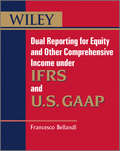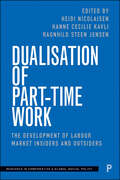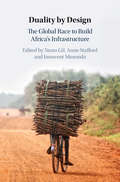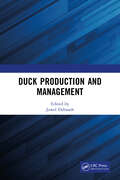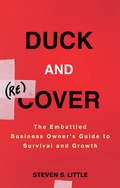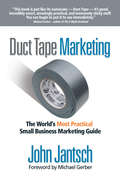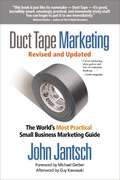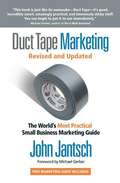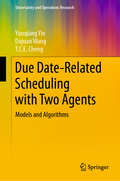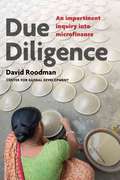- Table View
- List View
Dual Reporting for Equity and Other Comprehensive Income under IFRSs and U.S. GAAP
by Francesco BellandiUnder IFRS, U.S. GAAP, and the SEC rules and regulations, business enterprises must recognise measure and disclose information regarding equity items on the face of the statement of financial position, other specific statements, or in the notes to the financial statements. However, under both IFRS and U.S. GAAP there is no all-inclusive general standard on stockholders' equity. This book clarifies the process of reporting stockholders' equity in a manner which can be reconciled under all the relevant standards."Not only has the author addressed the informational needs of the players in the accounting industry, he has also drawn, based on his vast experience, practical implications of reporting under both standards." --Noraini Mohd Nasir, Journal of Financial Reporting and Accounting
Dual Sozialpädagogik studieren: Chancen, Herausforderungen und Belastungen in einem dynamischen Studienformat
by Simone HessDas Buch stellt hochschuldidaktische Konzepte zu dualen Studienformaten der Sozialpädagogik/Sozialen Arbeit vor und reflektiert die Faktoren, die wesentlich zur Professionalisierung von Studentinnen und Studenten beitragen. Es werden Möglichkeiten und Herausforderungen dieser Studienform dargestellt, die durch die Relationierung des akademisch-wissenschaftlichen und des betrieblich-praktischen Anteils entstehen.
Dual-Fuel Gas-Steam Power Block Analysis: Methodology And Continuous-time Mathematical Models (Power Systems)
by Anna Hnydiuk-StefanThis book presents the methodology and mathematical models for dual-fuel coal-gas power plants in two basic configurations: systems coupled in parallel and in series.Dual-fuel gas and steam systems, especially parallel systems, have great potential for modernizing existing combined heat and power (CHP) plants. This book presents calculations using a novel methodology applied to systems in continuous time and analyzes the impact of the investment profitability of the EU ETS (European Union Emissions Trading Scheme) derogation mechanism, which encourages enterprises to modernize existing generation units. It also includes a detailed case study of a coal power plant modernized by repowering with a gas turbine.The book is intended for researchers, market analysts, decision makers, power engineers and students.
Dualer Kundenwert und Kundenwertsteuerung auf Massenmärkten
by Kaveh RouhiDiese Arbeit befasst sich mit der integrierten Betrachtung des Wertes für Kunden (Customer Perceived Value) und den Wert der Kunden für Unternehmen (Customer Lifetime Value) im Commodity-Markt. Ziel dieser normativ geprägten Arbeit ist es, ein Framework zu entwickeln, anhand dessen sich das Marketing steuern lässt. Dazu werden sowohl Befragungsdaten als auch reale Transaktionsdaten eines Tankstellenbetreibers verwendet. Es wird gezeigt, dass Kunden mittels des Frameworks segmentiert, bewertet und priorisiert werden können. Schließlich werden anhand dessen Maßnahmen abgleitet und deren Effizienz mittels des Customer Lifetime Value gemessen.
Dualisation of Part-Time Work: The Development of Labour Market Insiders and Outsiders (Research in Comparative and Global Social Policy)
by Heidi Nicolaisen, Hanne Cecilie Kavli & Ragnhild Steen JensenePDF and ePUB available Open Access under CC-BY-NC-ND licence. This book brings together leading international authors from a number of fields to provide an up-to-date understanding of part-time work at national, sector, industry and workplace levels. The contributors critically examine part-time employment in different institutional settings across Europe, the USA, Australia and Korea. This analysis serves as a prism to investigate wider trends, particularly in female employment, including the continued increase in part-time work and processes that are increasingly creating dualisation and inequality between ‘good’ and ‘bad’ jobs.
Duality by Design: The Global Race to Build Africa's Infrastructure
by Anne Stafford Nuno Gil Innocent MusondaAfrica's rapid population growth and urbanisation has made its socioeconomic development a global priority. But as China ramps up its assistance in bridging Africa's basic infrastructure gap to the detriment of institutions building, warnings of a debt trap have followed. Building upon an extensive body of evidence, the editors argue that developing institutions and infrastructure are two equally desirable but organisationally incompatible objectives. In conceptualising this duality by design, a new theoretical framework proposes better understanding of the differing approaches to development espoused by traditional agencies, such as the World Bank, and emergent Chinese agencies. This new framing moves the debate away from the fruitless search for a 'superior' form of organising, and instead suggests looking for complementarities in competing forms of organising for development. For students and researchers in international business, strategic and public management, and complex systems, as well as practitioners in international development and business in emergent markets.
Duane Morris: Balancing Growth and Culture at a Law Firm
by Boris Groysberg Robin AbrahamsAfter nearly 100 years as a mid-size regional law firm, Duane Morris entered a period of spectacular growth led by CEO Sheldon Bonovitz. Originally founded by Quakers, the firm had a distinct organizational culture featuring a number of unique or unusual business practices: a transparent and flexible compensation system, practice-group integration across multiple offices, ancillary businesses, early adoption of financial reporting software, and consensus-based decision making. The firm was proud of its corporate culture and sought to maintain it as it grew, bringing in only people who would fit the culture, in small groups. In 2005, the firm completed its first merger, taking over a 64-person San Francisco firm. Growth was necessary to remain competitive, but could Duane Morris maintain its unique culture while bringing on large numbers of new attorneys?
Dubai - The Epicenter of Modern Innovation: A Guide to Implementing Innovation Strategies
by William R. Kennedy Aaron G. Amacher Gregory C. McLaughlinInternational and global in nature, Dubai - The Epicenter of Modern Innovation: A Guide to Implementing Innovation Strategies provides a roadmap for the successful implementation of innovation for companies and businesses currently working in the Middle East, the UAE, and more specifically, Dubai. The discussion focuses on implementing sustained innovation success within several industry segments, while identifying past, current, and future innovation-related successes that are leading to Dubai's rise as the epicenter of innovation in the Middle East and most notably, the world. The authors share key innovation leadership philosophies from Sheikh Mohammed bin Al Maktoum, recognized business leaders, and the highest levels in the UAE. This book: Features key leadership and innovation insights relative from the highest levels of government, including Sheikh Mohammed bin Al Maktoum and multiple UAE ministry officials. Focuses on the United Arab Emirates (UAE), most specifically, Dubai and the Nation’s preparation for hosting World Expo 2020. Contains numerous examples of past, present, and future innovations in Dubai. Provides an easy to implement innovation process management methodology, which has been tested to work in various businesses and organizations. Authored by individuals who have 'on the ground' experience living and working with the chief architects of Dubai's innovation vision and strategy. This book will attempt to take the reader through the construct of this new innovative revolution, particularly in Dubai, and provide a bird’s-eye view of how it came about. Most notably, the discussion will walk the reader through key milestones instrumental to Dubai’s success—such as the present and past leadership, culture, strategy, and strategic vision. In addition, the discussion will present an industry agnostic, agile and progressive approach to building and leading successful innovation teams through to a successful project out-come and the attributes of good innovation leadership.
Dubai Ports Authority (A)
by Andrew Mcafee Karen Ooms-Wall Lubna Al QasimiThe Dubai Ports Authority (DPA) wishes to digitize many of the documents it shares with its external partners, including shipping lines and agents, merchants, and the country's customs authority. DPA also wishes to automate the many document transmissions related to ships' manifests. At the time of the case, the worldwide shipping industry is characterized by low levels of automation, a proliferation of incompatible data standards, and many independent players. All of these factors complicate digitization efforts. DPA decides to write its manifest documentation system itself and must make several other decisions related to system implementation and rollout.
Dubai Ports World Debacle and Its Aftermath
by Julio J. RotembergDescribes the political ramifications in the United States of Dubai-based DP World's acquisition of London-based Peninsular and Oriental Steam Navigation Company (P&O). Because P&O operated some port terminals in the United States, DP World obtained clearance from the Committee on Foreign Investments in the United States before P&O shareholders approved the deal in February 2006. Nonetheless, a ruckus over port security erupted both in Congress and in the press and this ruckus led DP World to promise that it would relinquish the U.S. terminals of P&O. Also contains a brief description of Dubai and its relationship to the U.S., a discussion of issues related to port security, and a brief history of U.S. security concerns with foreign direct investment. Ends with a depiction of the Bills passed unanimously by the U.S. House and Senate to further regulate foreign investment in the wake of the DP World debacle.
Dubai in Crisis
by Noel MaurerOn November 25th, 2009, the small city-state of Dubai shook financial markets across the planet when the Dubai World holding companies announced that it would ask its creditors to standstill its debts. After three decades of phenomenal growth, something had gone off the rails with Dubai's development model. What caused the trouble? Was it simply a temporary setback or a sign that the city-state's needed to change its business model? Could Dubai maintain its independence from Abu Dhabi in the wake of the bailout? And if the emirate's current model was not sustainable, then how exactly should it change? This case explores all these issues, in light of the Great Recession, the geopolitical context, and Dubai's history.
Dubai: Debt, Development, and Crisis (A)
by Aldo Musacchio Andrew Goodman Claire QureshiOn November 25, 2009, the city state of Dubai stunned markets by announcing that Dubai World, its flagship state holding company, would seek a six-month "standstill" on at least $4 billion U.S. dollars of its $26 billion in debt obligations. This case describes Dubai's development strategy in detail and narrates how, as part of that strategy, a series of state-owned holding companies accumulated billions of dollars in debt. The (A) case ends as Sheikh Ahmed bin Saeed, chairman of Dubai's Fiscal Committee, has to decide what to do about the financial troubles of Dubai World and other state-owned holding companies. The case presents Sheikh Ahmed bin Saeed having to decide among three options: the Dubai government can guarantee the debt, they can renegotiate the debt, or they can walk away (i.e., default). The B case describes the decision and the reactions to this decision around the world and presents a new decision on the part of bond holders of Dubai's state-owned holding companies. The C case briefly analyzes the advantages and disadvantages of Dubai's bankruptcy procedures, both for investors and for the holding companies of Dubai.
Dubai: Gilded Cage
by Syed AliThis revealing portrait of the famously wealthy Persian Gulf city investigates the human cost of its miraculous rise to global prominence. In less than two decades, Dubai has transformed itself from an obscure territory of the United Arab Emirates into a global center for business, tourism, and luxury living. With astonishing skyscrapers and tax-free incomes, its rulers have made Dubai into a playground for the global elite while skillfully downplaying its systemic human rights abuses and suppression of dissent. It is a fascinating case study in light-speed urban development, massive immigration, and vertiginous inequality. In Dubai: Gilded Cage, sociologist Syed Ali delves beneath the dazzling surface to analyze how—and at what cost—Dubai has achieved its success. Ali brings alive a society rigidly divided between expatriate Westerners enjoying opulent lifestyles on short-term work visas, native Emiratis who are largely passive observers, and workers from the developing world who provide the manual labor and domestic service needed to keep the emirate running, often at great personal cost. &“At last, a comprehensive expose of the economic and sexual exploitation that erected this utopia of greed. Syed Ali has seen the future in Dubai and it doesn&’t work.&” —Mike Davis, author of Planet of Slums
Dubai: Global Economy
by Richard H.K. Vietor Nicole ForrestThis case, along with Saudi Arabia: Modern Reform, Enduring Stability (709-042), provides an opportunity to discuss Saudi Arabia's efforts to modernize, without really Westernizing, in sharp contrast to Dubai, a nearby Arab Emirate. As Saudi Arabia's development strategy unfolds in the past six years, it is contrasted to social and political pressures within the country, volatility in global oil markets and severe political problems in the Middle East.
Ducati
by Giovanni GavettiFocuses on the turnaround and strategic repositioning of Ducati, an Italian maker of high-end sport motorcycles, and describes the current concerns with the growth prospects of the company. Federico Minoli, the CEO and strategic mind behind the turnaround, knew that Ducati could not grow indefinitely in its current niche. One alternative was to attack Harley Davidson's niche with a Ducati interpretation of a cruiser.
Ducati & Texas Pacific Group: A
by William J. Coughlin Walter KuemmerleDescribes the attempt of Texas Pacific Group (TPG), a buyout firm, to purchase a controlling stake in Ducati Motor, the world's leading high-performance motorcycle company, based in Bologna, Italy. Ducati is part of Cagiva Group, a family-controlled industrial group. Cagiva has fallen on hard times and Ducati is the crown jewel in the group. Yet even Ducati is under great financial pressure and short on working capital. Abel Halpern, a partner at TPG, is frustrated because a deal with the owners seems to be an ever-moving target. Although TPG has negotiated with the seller for almost a year. In spite of costly due diligence efforts by TPG, Abel Halpern is now ready to walk away from the deal. In his decision he needs to consider not only valuation and the feasibility of hiring new management to turn the company around but also the feasibility of an eventual exit via the public markets in Italy.
Duck Production and Management
by Jowel DebnathThis book covers nearly all the aspects of duck rearing system with various duck genetic resources of India, their nutritional requirements, care management, diseases and prevention, slaughter, grading, packaging of meat, nutritional importance of meat & egg and integrated farming. To make this book more competent for farmers, enlisted certain drugs for treatment of different diseases of duck and vaccination schedule has also been included in the text. References have been included in this book to refer the interested reader for details understanding of duck rearing system. The language is kept simple and lucid for ease of understanding. This book will find right place in the hands of researchers, veterinary graduates, students of the animal sciences and farmers who are engaged in duck farming.
Duck and Recover
by Steven S. LittleBusiness growth expert Steven S. Little gives you the real-world strategies you need to navigate your business through economic uncertaintyIf you're a business owner or leader, you're no doubt feeling inundated on all sides by the gathering forces of this financial downturn--shrinking revenues, tightening resources, anxious workers, plunging profits. When economic storms hit, it's the clear-minded and action-oriented leader that ultimately guides their business to success. In order to position your business for the growth opportunities ahead, it is imperative for you to address your most critical issues now.Duck and (re)Cover is the ultimate business owner's guide to prevailing and prospering through tough economic times. It questions much of the "conventional wisdom" we all hear about recessions and instead offers an irreverently common-sense approach to survival and growth in the midst of economic uncertainty. This book focuses on the most significant challenges and opportunities facing embattled businesses today.Recommends specific, and effective strategies for keeping your business up and running, even if the economy continues to stallIncludes a wealth of been-there-done-that advice that will help you clear your own path to sustainable, profitable growthWritten by Steven S. Little, former president of three fast-growth companies and author of The Seven Irrefutable Rules of Small Business GrowthNow is not the time for timidity. Instead, make the bold moves recommend here to not only weather the storm but to chart a course for your ultimate destination.
Duckworth Industries, Inc.--Incentive Compensation Programs
by William E. FruhanA private company is considering an introduction of a long-run incentive compensation system in which payoffs to managers are determined by the economic value added for shareholders by their individual business units. The proposed new system is compared to a number of earlier incentive schemes utilized by the firm.
Duct Tape Marketing
by John JantschDuct Tape Marketing is the small business marketing road map - A collection of proven tools and tactics woven together in a step-by-step marketing system that shows small business owners exactly what to do to market and grow their businesses. This guide combines insights gained from over twenty years of successfully working, in the field, with real-life small businesses. There are no theoretical complexities presented in Duct Tape Marketing - just simple, effective and affordable marketing that sticks. CAREFUL! Duct tape is a serious tool... it sticks where you put it. So are the ideas in this book. If you're ready to make a commitment and are willing to make something happen, John's book is a great place to start.--Seth Godin, author of Purple Cow For all those who wonder why John Jantsch has become the leading advisor and coach to small businesses everywhere, Duct Tape Marketing is the answer. I have never read a business book that is as packed with hands-on, actionable information as this one. There are takeaways in every paragraph, and the success of John's blog is living proof that they work. Duct Tape Marketing should be required reading for anyone who is building a business, or thinking about it.--Bo Burlingham, editor-at-large, Inc. magazine, and author of Small Giants: Companies That Choose To Be Great Instead of Big Duct Tape Marketing is a worthy addition to the growing library of how-to books on small business marketing -- concise, clear, practical, and packed with great ideas to boost your bottom line.--Bob Bly, author of The White Paper Handbook With the world suffering from depleted reserves of trust, a business that sells plenty of it every day tends to create the most value. The great thing about trust as a product feature is that it delivers exceptional returns. With this book, John Jantsch has zeroed in on exactly what small businesses need to sell every day, every hour.--Ben McConnell, co-author of Creating Customer Evangelists: How Loyal Customers Become a Volunteer Sales Force John Jantsch has provided small businesses with the perfect perspective for maximizing all marketing activities - offline and on. Jantsch has the plan to help you thrive in the world of business today. Read it, all your competitors will.--John Battelle, cofounding editor or Wired and author of The Search: How Google and Its Rivals Rewrote the Rules of Business and Transformed Our Culture Duct Tape Marketing is a great read for anyone in business. It has fresh ideas laid out in a practical and useable way. I highly recommend this book for growing any business.--Dr. Ivan Misner, Founder of BNI and Co-author of the New York Times bestseller, Masters of Networking
Duct Tape Marketing Revised & Updated: The World's Most Practical Small Business Marketing Guide
by John JantschIs Your Marketing as Simple, Effective, and Affordable as Duct Tape?Let's face it, as a small business owner, you are really in the business of marketing. The problem for most small business owners is that they suffer from "marketing idea of the week" syndrome instead of implementing a systematic approach to the problem of small business marketing.In Duct Tape Marketing, renowned Small Business Marketing guru John Jantsch shows you how to develop and execute a marketing plan that will give your business the life and longevity you knew you could have when you made that decision to go out on your own.CAREFUL! Duct tape is a serious tool... it sticks where you put it. So are the ideas in this book. If you're ready to make a commitment and are willing to make something happen, John's book is a great place to start. -Seth Godin, author of Purple Cow For all those who wonder why John Jantsch has become the leading advisor and coach to small businesses everywhere, Duct Tape Marketing is the answer. I have never read a business book that is as packed with hands-on, actionable information as this one. There are takeaways in every paragraph, and the success of John's blog is living proof that they work. Duct Tape Marketing should be required reading for anyone who is building a business, or thinking about it. -Bo Burlingham, editor-at-large, Inc. magazine, and author of Small Giants: Companies That Choose To Be Great Instead of Big Duct Tape Marketing is a worthy addition to the growing library of how-to books on small business marketing-concise, clear, practical, and packed with great ideas to boost your bottom line. -Bob Bly, author of The White Paper Handbook With the world suffering from depleted reserves of trust, a business that sells plenty of it every day tends to create the most value. The great thing about trust as a product feature is that it delivers exceptional returns. With this book, John Jantsch has zeroed in on exactly what small businesses need to sell every day, every hour. -Ben McConnell, co-author of Creating Customer Evangelists: How Loyal Customers Become a Volunteer Sales Force John Jantsch has provided small businesses with the perfect perspective for maximizing all marketing activities - offline and on. Jantsch has the plan to help you thrive in the world of business today. Read it, all your competitors will. -John Battelle, cofounding editor or Wired and author of The Search: How Google and Its Rivals Rewrote the Rules of Business and Transformed Our Culture Duct Tape Marketing is a great read for anyone in business. It has fresh ideas laid out in a practical and useable way. I highly recommend this book for growing any business. -Dr. Ivan Misner, Founder of BNI and Co-author of the New York Times bestseller, Masters of Networking
Duct Tape Marketing: The World's Most Practical Small Business Marketing Guide
by John JantschLet's face it, as a small business owner, you are really in the business of marketing. The problem for most small business owners is that they suffer from "marketing idea of the week" syndrome instead of implementing a systematic approach to the problem of small business marketing.
Duct Tape Selling
by John JantschMany of the areas that salespeople struggle with these days have long been the domain of marketers, according to bestselling author John Jantsch. The traditional business model dictates that marketers own the message while sellers own the relationships. But now, Jantsch flips the usual sales approach on its head. It's no longer enough to view a salesperson's job as closing. Today's superstars must attract, teach, convert, serve, and measure while developing a personal brand that stands for trust and expertise. In Duct Tape Selling, Jantsch shows how to tackle a changing sales environment, whether you're an individual or charged with leading a sales team. You will learn to think like a marketer as you: Create an expert platform Become an authority in your field Mine networks to create critical relationships within your company and among your clients Build and utilize your Sales Hourglass Finish the sale and stay connected Make referrals an automatic part of your process As Jantsch writes: "Most people already know that the days of knocking on doors and hard-selling are over. But as I travel around the world speaking to groups of business owners, marketers, and sales professionals, the number one question I'm asked is, 'What do we do now?' "I've written this book specifically to answer that question. At the heart of it, marketing and sales have become activities that no longer simply support each other so much as feed off of each other's activity. Sales professionals must think and act like marketers in order to completely reframe their role in the mind of the customer."
Due Date-Related Scheduling with Two Agents: Models and Algorithms (Uncertainty and Operations Research)
by Yunqiang Yin Dujuan Wang T.C.E. ChengThis book provides an introduction to the models, methods, and results of some due date-related scheduling problems in the field of multiagent scheduling. In multiagent scheduling, two or more agents share a common processing resource and each agent wants to optimize its own objective function with respect to its own set of jobs. Since the agents have conflicting objective functions, they have to negotiate among themselves with regard to sharing the common resource to optimize their own objective functions. A key feature of due date-related scheduling concerns the way in which due dates are considered: they can be given parameters or decision variables. For the former case, the motivation stems from the need to improve inventory and production management. For the latter case, due date assignment becomes a challenging issue since the decision-maker has to balance inventory holding costs against the benefits of fulfifilling orders in time.As for due dates, this book addresses the following three different scenarios: (i) The due dates of the jobs from either one or both of the two agents are decision variables, which are determined using some due date assignment models; (ii) The due dates of jobs in each job set are considered as given parameters, whereas which due date corresponds to a given job needs to determine; and (iii) The due date of each job is exogenously given. When the last case is involved, the objective function of each agent is related to the number of just-in-time jobs that are completed exactly on their due dates.For each considered scenario, depending on the model settings, and on the objective function of each agent, this book addresses the complexity, and the design of efficient exact or approximated algorithms.This book aims at introducing the author's research achievements in due date-related scheduling with two agents. It is written for researchers and Ph.D. students working in scheduling theory and other members of scientific community who are interested in recent scheduling models. Our goal is to enable the reader to know about some new achievements on this topic.
Due Diligence
by David RoodmanThe idea that small loans can help poor families build businesses and exit poverty has blossomed into a global movement. The concept has captured the public imagination, drawn in billions of dollars, reached millions of customers, and garnered a Nobel Prize. Radical in its suggestion that the poor are creditworthy and conservative in its insistence on individual accountability, the idea has expanded beyond credit into savings, insurance, and money transfers, earning the name microfinance. But is it the boon so many think it is?Readers of David Roodman's openbook blog will immediately recognize his thorough, straightforward, and trenchant analysis. Due Diligence, written entirely in public with input from readers, probes the truth about microfinance to guide governments, foundations, investors, and private citizens who support financial services for poor people. In particular, it explains the need to deemphasize microcredit in favor of other financial services for the poor.
